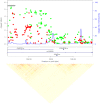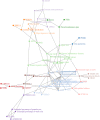A multilayered post-GWAS assessment on genetic susceptibility to pancreatic cancer
- PMID: 33517887
- PMCID: PMC7849104
- DOI: 10.1186/s13073-020-00816-4
A multilayered post-GWAS assessment on genetic susceptibility to pancreatic cancer
Abstract
Background: Pancreatic cancer (PC) is a complex disease in which both non-genetic and genetic factors interplay. To date, 40 GWAS hits have been associated with PC risk in individuals of European descent, explaining 4.1% of the phenotypic variance.
Methods: We complemented a new conventional PC GWAS (1D) with genome spatial autocorrelation analysis (2D) permitting to prioritize low frequency variants not detected by GWAS. These were further expanded via Hi-C map (3D) interactions to gain additional insight into the inherited basis of PC. In silico functional analysis of public genomic information allowed prioritization of potentially relevant candidate variants.
Results: We identified several new variants located in genes for which there is experimental evidence of their implication in the biology and function of pancreatic acinar cells. Among them is a novel independent variant in NR5A2 (rs3790840) with a meta-analysis p value = 5.91E-06 in 1D approach and a Local Moran's Index (LMI) = 7.76 in 2D approach. We also identified a multi-hit region in CASC8-a lncRNA associated with pancreatic carcinogenesis-with a lowest p value = 6.91E-05. Importantly, two new PC loci were identified both by 2D and 3D approaches: SIAH3 (LMI = 18.24), CTRB2/BCAR1 (LMI = 6.03), in addition to a chromatin interacting region in XBP1-a major regulator of the ER stress and unfolded protein responses in acinar cells-identified by 3D; all of them with a strong in silico functional support.
Conclusions: This multi-step strategy, combined with an in-depth in silico functional analysis, offers a comprehensive approach to advance the study of PC genetic susceptibility and could be applied to other diseases.
Keywords: 3D genomic structure; Genetic susceptibility; Genome-wide association analysis; Local indices of genome spatial autocorrelation; Pancreatic cancer risk.
Conflict of interest statement
The authors declare that they have no competing interests.
Figures





References
Publication types
MeSH terms
Substances
Grants and funding
LinkOut - more resources
Full Text Sources
Other Literature Sources
Medical

